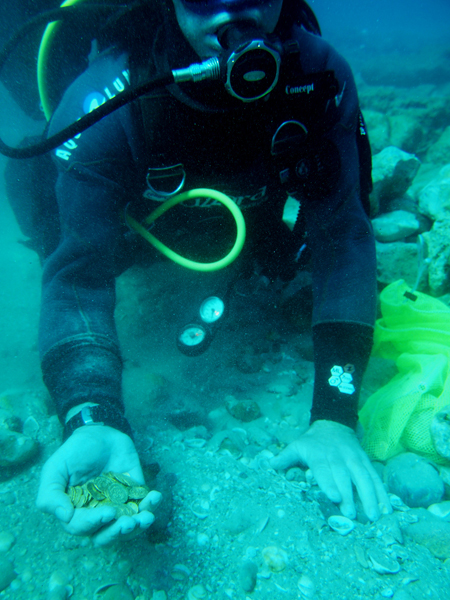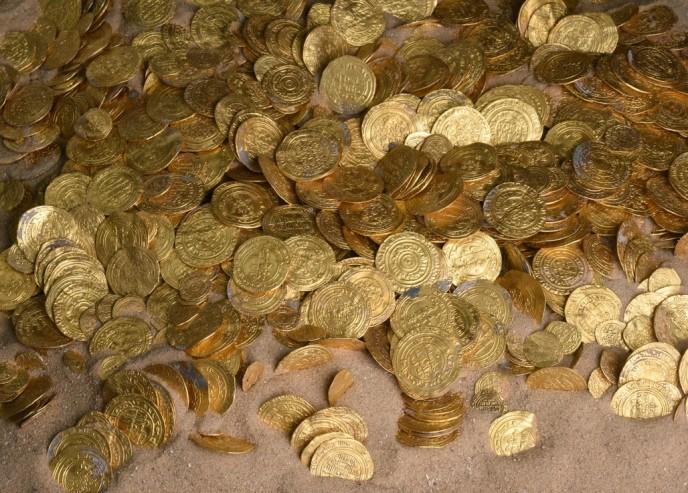
The largest treasure of gold coins discovered in Israel has been made public. The nearly 2,000 gold coins from the Fatimid period (eleventh century CE) were discovered by a group of divers on the seabed in the ancient harbor in Caesarea National Park.

The divers first thought the coins were remnants of a children’s game but upon closer inspection realized they had found “the real thing” and swam up to the surface to inform the director of the dive club about their find. The message was passed on to the Marine Archaeology Unit of the Israel Antiquities Authority.
Divers of the Israel Antiquities Authority went together with the original group of divers out to where the coins were found and using a metal detector discovered almost 2,000 gold coins in different denominations: a dinar, half dinar and quarter dinar, of various dimensions and weight.

“The discovery of such a large hoard of coins that had such tremendous economic power in antiquity raises several possibilities regarding its presence on the seabed. There is probably a shipwreck there of an official treasury boat which was on its way to the central government in Egypt with taxes that had been collected. Perhaps the treasure of coins was meant to pay the salaries of the Fatimid military garrison which was stationed in Caesarea and protected the city. Another theory is that the treasure was money belonging to a large merchant ship that traded with the coastal cities and the port on the Mediterranean Sea and sank there,” said Kobi Sharvit, director of the Marine Archaeology Unit of the Israel Antiquities Authority.
Sharvit said this rare historical evidence of life in the past was exposed during winter storms.
“In the Marine Archaeological Unit of the Israel Antiquities Authority they are hoping that with the salvage excavations that will be conducted there, it will be possible to supplement our understanding of the entire archaeological context, and thus answer the many questions that still remain unanswered about the treasure,” he said.

The coins, despite being at the bottom of the sea for some a thousand years, are in excellent condition.
“They did not require any cleaning or conservation intervention from the metallurgical laboratory. This is because gold is a noble metal and is not affected by air or water. The coins that were exposed also remained in the monetary circulation after the Crusader conquest, particularly in the port cities through which international commerce was conducted. Several of the coins that were found in the assemblage were bent and exhibit teeth and bite marks, evidence they were ‘physically’ inspected by their owners or the merchants. Other coins bear signs of wear and abrasion from use while others seem as though they were just minted,” said Robert Cole, an expert numismaticist with the Israel Antiquities Authority.
The Law of Antiquities in Israel states that “all antiquities belong to the State and that not reporting or removing antiquities from their location, or selling or trading them is an offense punishable by up to five years imprisonment,” said Sharvit. He added that the divers who found the treasure and reported it are model citizens.
The Caesarea Development Company and Nature and Parks Authority also welcomed the discovery of the treasure. “There is no doubt that the discovery of the impressive treasure highlights the uniqueness of Caesarea as an ancient port city with rich history and cultural heritage,” a Parks Authority statement read. “After 2,000 years it is still capable of captivating its many visitors, of continuing to innovate and surprise again when other parts of its mysterious past are revealed in the ground and in the sea.”













